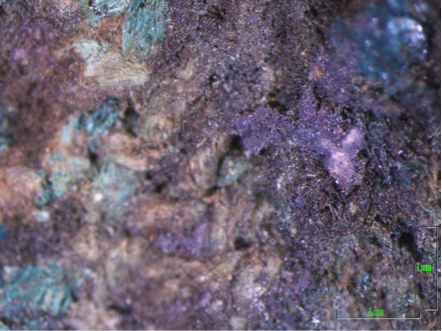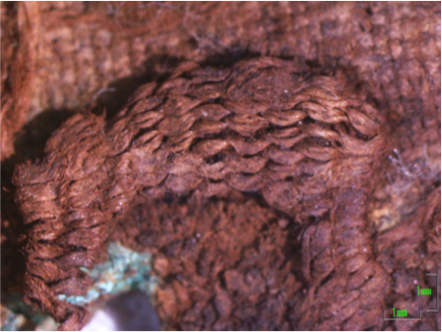Spantidaki, Stella. “Elite fabrics from the Grave Circles of Mycenae.” CHS Research Bulletin 10 (2022). http://nrs.harvard.edu/URN-3:HLNC.ESSAY:102284671.
Early Career Fellow in Hellenic Studies 2021-22
Introduction
The Mycenaean culture was the first Greek civilization, placed in the Late Bronze Age, between c. 1600 and 1100 BCE, in the so-called Late Helladic period (LH). We know from the preserved material evidence that the Mycenaeans were great warriors, dynamic traders, skilled craftsmen and engineers who created a rich and powerful palatial culture, took over the Minoan culture in Crete and established themselves as rulers of the Greek mainland and the islands. They were the first to adopt a foreign writing system to record an early version of the Greek language, the Linear B script. Interestingly, we know much more about their era of prosperity and their decline (LH III), than the emergence of their civilization (LH I-II). My project focuses on previously unstudied material and introduces the Mycenaeans through their textiles, thus generating new knowledge about the early Mycenaean society and its textile industry.
Most of the information about the Mycenaean textile culture and technology actually derives from research on the palatial period (LH III) and is substantially based on indirect sources, such as written documents, textile tools, iconography and archaeological remains (Nosch 2008, 2020; del Freo et al. 2010; Kaza Papageorgiou and Kardamaki 2011, 201-208; Nosch and Laffineur 2012; Andersson and Nosch 2015; Shaw and Chapin 2015; Siennicka et al. 2018). Indeed, it is known that the Mycenaean palaces controlled a sophisticated textile industry that produced large quantities of various types of textiles, involved a great part of the population and represented a significant branch of the economy. Yet, our knowledge about the textiles of the early Mycenaean period is very limited.
The corpus
My project as an Early Career Fellow at the Center for Hellenic Studies constitutes an unprecedented opportunity to explore the secrets of the early Mycenaean textile production by working on actual textiles with state-of-the-art scientific techniques. The main research object is a large textile corpus from Mycenae, conserved in the Prehistoric Collection of the National Archaeological Museum, Athens. It is composed by funerary textiles discovered in inhumation graves, in the Grave Circles A (c. 1600-1500 BCE) and B (c. 1650-1550 BCE). These Grave Circles were the resting place of the Mycenaean elite and yielded numerous impressive burial goods (Karo 1930/33; Mylonas 1973). From this impressive group of textiles, only one has been studied in the past and partially published (Spantidaki and Moulhérat 2012, 192, figs. 7.4-7.6), thus constituting the current research a unique endeavour in the field of Bronze Age textiles.
This research is part of a wider project aiming to generate new technical data and answer larger questions about the characteristics of the early Mycenaean textile culture. What were the details of the production (materials, fibre processing, production and decoration techniques)? What do we learn about the connection of the early to the later Mycenaean textile industry: is there a traceable tradition that continues into the palatial period or are there elements that disappear in time and are not present in later sources? What are the characteristics of the elite textiles of the period?
Although my CHS Fellowship coincided with the pandemic, causing various delays and hindrances, considerable work was done and the research is ongoing. During this period, we proceeded with the stereoscopic examination of the largest part of the corpus, which indicated immediately that most of the fabrics are preserved in a very good condition (in an organic or partially mineralized state). The stereoscopic study benefited from the kind collaboration and valuable expertise of Dr Christophe Moulhérat from Sorbonne University Abu Dhabi, a world expert on this textile documentation method.
This allowed us to move to the second stage into their examination with microscopic techniques, as well as the implementation of scientific analyses, for which reason samples of the textiles have been collected and prepared.
All through my research under the CHS Fellowship I have benefited by the remote access to Harvard University library and the digital resources provided, while during my stay at CHS in Washington DC physical access to the library to study the latest scholarship on Late Bronze Age textile technology further allowed me to write synthetic parts of my study.
Research results
The stereoscopic examination of the textiles from the Grave Circles of Mycenae so far indicates the presence of at least nineteen different fabrics made both in plant and animal fibers. The predominant fibers are plant fibers and it seems that flax is the most common material, as is the case generally in Greek archaeological textiles (Spantidaki and Moulhérat 2012; Spantidaki 2016). In most fragments, we observe that the treatment of the fibers, which corresponds to the preparation for spinning, has been carried out with much care; this is indicated by well separated and parallel fibers resulting to very clean and shiny threads. All fabrics are woven on the loom and display the two main variations of the plain weave, namely balanced tabby (equal number of threads in both directions) and weft-faced tabby (more weft threads than warp threads). Moreover, three fabrics conserve traces of edges; as they are usually reinforced, edges are indeed among the elements which are often preserved in archaeological textile remains.
Two exceptional cases, one from each Grave Circle, present particular interest since they exhibit technical characteristics attributed to royal textiles throughout history. The first one (Grave Circle A, Tomb V, inv. no. 816, 1600-1500 BCE) is a group of textiles conserved in six larger and many smaller fragments and consisting of at least three different fabric qualities. One balanced tabby fabric displays traces of a bright purple color and ultraspectral imaging has confirmed the presence of real shellfish purple (I am grateful to Philippe Walter and Clarisse Chavanne from the Sorbonne University for carrying out the in-situ analysis) (fig. 1). Although evidence suggests the use of marine mollusks for dyeing since the Early Bronze Age (Marín-Aguilera et al. 2018), finds of purple dyed textiles are extremely rare. This identification would make the textile from Mycenae the oldest purple-dyed fabric currently known in Greece.


The second case (Grave Circle B, Tomb N, inv. no. 9651, 1650-1550 BCE) is a very degraded, dark-colored fabric, which displays evidence of patterns created with an additional, well preserved, weft thread in the tapestry technique (fig. 2). Five tapestry patterns have been identified. Tapestry decoration is a demanding and time-consuming technique that creates patterns with an additional thread on a background fabric. Through this technique, the weaver can create a wealth of designs and decorations, revolutionizing textile technology. The oldest tapestry in Greece until now was discovered among the Sub-Mycenaean Lefkandi textiles (Margariti and Spantidaki 2020). The discovery of tapestry in this fabric from LHI Mycenae, making it the oldest example in Greece, offers a completely new understanding of the conception and evolution of tapestry technique already in the Aegean Bronze Age. Rich decoration, such as tapestry, and purple dyeing have always been considered as royal and aristocratic symbols (Marín-Aguilera et al. 2018; Nosch 2021); this identification strongly suggests that the textiles chosen to be buried along the Mycenaean elite were of the same high quality as the impressive artefacts that confirmed the frequent Homeric expression of the Rich-in-Gold Mycenae (Πολύχρυσαι Μυκῆναι).
As part of communicating the ideas and results of my CHS Research Fellowship project on Mycenaean textiles, I have presented a paper at the third International Scientific Meeting ‘Archaeological work in the Peloponnese’ in summer 2021 and I am preparing a specialized study on the technology of the textile remains to be published in 2023. The overall aim of the project is to publish this Mycenaean textile corpus in a monograph examining notions like elite textiles, tradition, innovation and development of the early Greek textile technology from Bronze Age to the Iron Age.
Selected Bibliography
Andersson E. Strand and M.-L. Nosch (eds.) 2015 Tools, Textiles and Contexts. Investigating Textile Production in the Aegean and Eastern Mediterranean Bronze Age. Oxford, Oxbow Books, Ancient Textiles Series 21.
Del Freo M., Nosch M.-L., and Rougemont F. 2010 The Terminology of Textiles in the Linear B Tablets, Including Some Considerations on Linear A Logograms and Abbreviations, in C. Michel and M.-L. Nosch (eds.) Textile Terminologies in the Ancient Near East and Mediterranean from the Third to the First Millennia BC. Oxford, Oxbow Books, Ancient Textiles Series 8, 338-373.
Karo G. 1930/1933 Die Schachtgräber von Mykenai, 2 vols. Verlag F. Bruckmann Ag. München.
Kaza Papageorgiou K. and Kardamaki E. 2011 Κοντοπήγαδο Αλίμου Αττικής. Οικισμός των ΠΕ και ΥΕ χρόνων και ΥΕ εργαστηριακή εγκατάσταση, ΑΕ 150, 197-274.
Marín-Aguilera B., Iacono F. and Gleba M. 2018 Colouring the Mediterranean: Production and Consumption of Purple-dyed Textiles in Pre-Roman Times, Journal of Mediterranean Archaeology 31.2, 127-154.
Margariti C. and Spantidaki S. 2020 Revisiting the Lefkandi warrior, in M. Bustamante-Álvarez, E.H. Sánchez López, J. Jiménez Ávila (eds.) Purpureae Vestes VII. Proceedings of the VIIth International Symposium on Textiles and Dyes in the Ancient Mediterranean World (Granada, Spain 2-4 October 2019). Granada, 401-412.
Mylonas G. 1973 Ο ταφικός κύκλος Β των Μυκηνών, 2 vols. Athens.
Nosch M.-L. 2008 Haute Couture in the Bronze Age: A History of Minoan Female Costumes from Thera, in M. Gleba, C. Munkholt and M.-L. Nosch (eds.) Dressing the Past. Oxford, Oxbow Books, Ancient Textiles Series 3.
Nosch M.-L. 2020 Textiles in the Late Bronze Age III (14th-12th centuries) and the Early Iron Age (11th-7th centuries) in the Aegean, in I. Lemos and A. Kotsonas (eds.) Blackwell’s companion to the archaeology of early Greece and the Mediterranean. Wiley, Blackwell, 589-602.
Nosch M.-L. B. 2021 Textiles, vêtements et parures des royautés en Grèce avant Alexandre, in M.-J. Werlings, A. Guieu-Coppolani and J. Zurbach (eds.) Le pouvoir et la parole. Mélanges en mémoire de Pierre Carlier. Presses de l’ADRA, Nancy, 103-138.
Nosch M.-L. and R. Laffineur (eds.) 2012 Kosmos: Jewellery, Adornment and Textiles in the Aegean Bronze Age, Proceedings of the 13th International Aegean Conference, University of Copenhagen, Danish National Research Foundation’s Centre for Textile Research, 21–26 April 2010. Leuven and Liège, Peeters.
Shaw M.C. and Chapin A. 2015 (eds.) Woven Threads. Patterned Textiles of the Aegean Bronze Age. Oxford, Oxbow Books, Ancient Textiles Series 22.
Siennicka M., Rahmstorf L. and Ulanowska A. (eds.) 2018 First Textiles. The beginnings of Textile Manufacture in Europe and the Mediterranean. Oxford, Oxbow Books, Ancient Textiles Series 32.
Spantidaki S. 2016 Textile Production in Classical Athens. Oxford, Oxbow Books, Ancient Textiles Series 27.Spantidaki Y. and Moulhérat C. 2012 Greece, in M. Gleba and U. Mannering (eds.) Textiles and Textile Production in Europe: From Prehistory to AD 400. Oxford, Oxbow Books, Ancient Textiles Series 11, p. 185-202.
List of Figures
Figure 1: Stereoscope detail of the textile inv. no. 816, Mycenae, Grave Circle A, Tomb V, 1600-1500 BCE with traces of purple dye. Photo ARTEX/Stella Spantidaki.
Figure 2: Stereoscope detail of the textile inv. no. 9651, Mycenae, Grave Circle B, Tomb N, 1650-1550 BCE, depicting the largest tapestry pattern conserved. Photo ARTEX/Stella Spantidaki.
